Yarner Wood
Yarner Wood lies within Dartmoor National Park. Nestled in a valley, this species-abundant woodland is a couple of miles away from Haytor and the nearest town, Bovey Tracey. Yarner has a definite aura about it and can reveal a different character depending on the season.
But we were in no particular hurry to get there on this occasion. A walk anywhere near Bovey Tracey usually provides an excuse to stop off at the Edgemoor Hotel. A cheese platter and a pint later and I was even more inclined to stay put for a bit longer. Meanwhile Sherry (armed with camera as always) wandered in the grounds and did battle with the breeze. Trying to capture a clear shot of a white crab spider, she eventually accepted defeat. When we finally decided to make a move a moth fluttered weakly down to the gravel in the car park in front of us. Then its wings were in burst mode and the creature made a beeline for the shrubbery. We closed in cautiously, taking note of its feathery antennae.
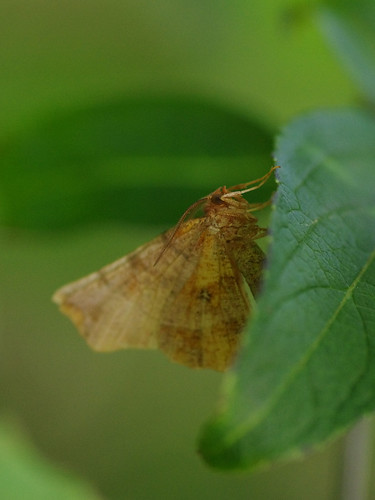
Early Thorn Moth (Selenia dentaria)
This was the clearest shot and after the usual round of checks in the guides and on sites, I was able to identify it. The Early Thorn is a common moth and known to produce two broods per year. Most of the photos I've seen online show the darker first brood. The specimen above is an example of the paler sequel.
We then briefly wandered in the garden at the back of the hotel where two different species of hover flies came to a Shasta Daisy streaked by sunlight.
Then it was onto Yarner Wood. Since our last visit, a new bird hide has been added and named 'the Pond Hide.' It must have been constructed quite recently because inside there was the scent of fresh wood. Outside, the birds were clearly enjoying the feeders. A Coal Tit came and went and then returned, and we marvelled at the acrobatics of a nuthatch, clinging on head down to the feeder and then the trunk of a nearby tree.
We then started our circuit of the reserve, going right and up to open ground.
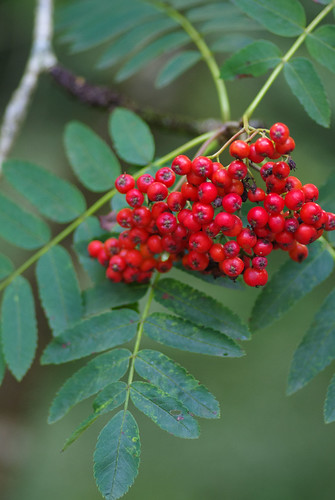
Berries of the Common Rowan Tree (Sorbus aucuparia)
These berries are in abundance at the moment but given a matter of months and a cold snap or two, they could well be stripped clean by redwings on their sojourn from Scandinavia.

Slender Rush (Juncus tenuis)
I jumped hastily to the wrong conclusion with the species above. I thought these had to be Toad Rushes but they are found mostly in estuarine habitats. So instead I have plumped for the Slender Rush.
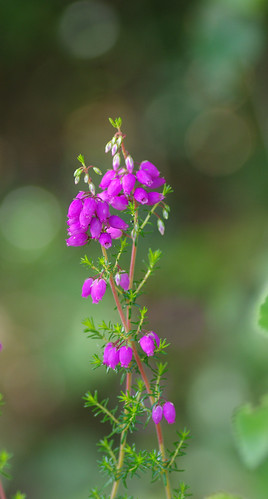
Bell Heather (Erica cinerea)

Heather (Calluna vulgaris)
Both these species create a canvas gloriously tinged with purples and pinks in summer. We had gone to the edge of the wood and were walking on an outer path. Out in the open, away from the cool shade of broad-leaved trees it seemed at least ten degrees warmer.

A type of gorse
One day I might be able to solve the conundrum of which Gorse species (Common, Western or Dwarf) is which. Until then I will just have to be contented with admiring the colour and the coconut scent of the flowers.
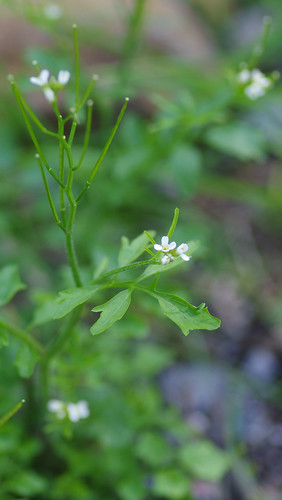

Wavy Bitter-cress (Cardamine flexuosa)
I have noticed this species growing outside our front door this year. They seem to love gravel and can easily establish roots in gaps of concrete.
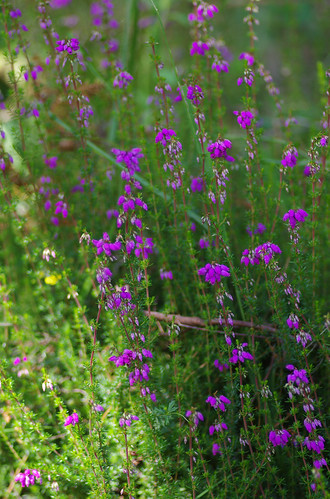
More Bell Heather

An unidentifiable moss
I have been flummoxed by grasses and am now completely mystified by mosses. Another field guide is required. At this rate I will have to carry more books than a hod-carrier carries bricks!
I thought the bits springing from the moss would help me identify the species. I did not realise that these are the fruits of mosses and that all mosses have them!
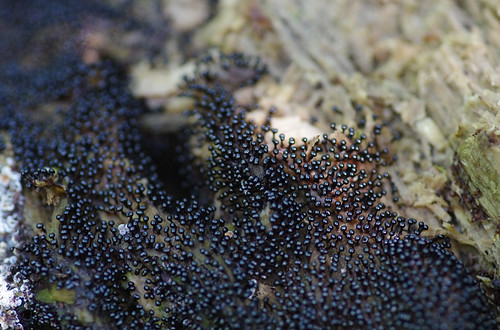
and an unidentifiable fungi
And while I'm on the familiar theme of not being able to identify things, here are some particularly perplexing fungi. I laboriously looked from cover to cover in the Roger Phillips guide and could not find a single match. At first I was tricked into thinking the sight above to be a swarm of ants. The likelihood is that these tiny liquorice buttons will grow into something bigger, considerably different - something that I might be able to actually pinpoint later in the year.
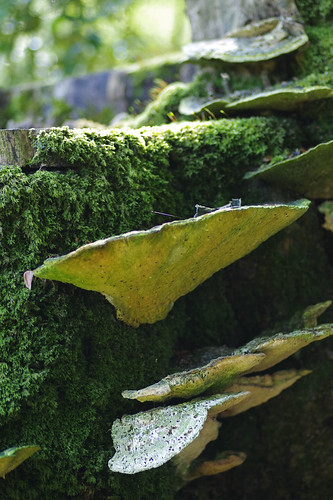
Lumpy Bracket (Trametes gibbosa)
These fungi were easier to find. It's always a good idea to take note of where they are growing. In this case it was the moss-covered, felled trunk of a beech tree. The pores underneath were also distinctive.
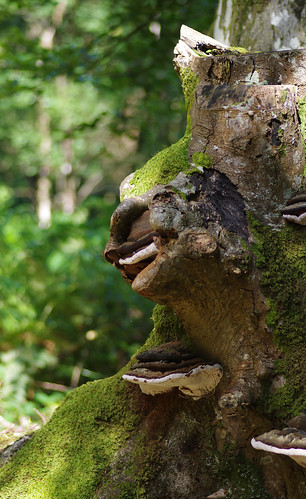
Southern Bracket (Ganoderma australe)
The profile here put me in mind of a warty face - perhaps one of the witches in Macbeth?
I have opted for Southern Bracket here although there is an outside chance they could have been Artist's Bracket. Both species share similar characteristics. At the top of each specimen, the ripe spores can give trees a dusting of cocoa.
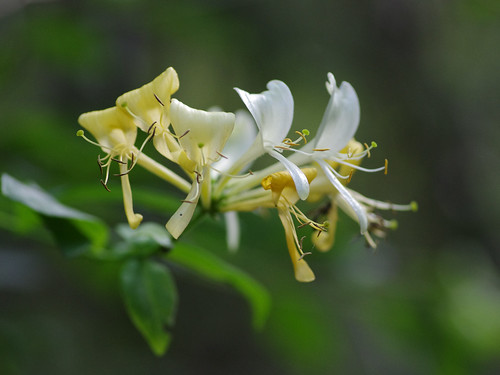
Honeysuckle (Lonicera periclymenum)
It's always a pleasure to see honeysuckle out in the wild. The stigma and stamens of these flowers was particularly striking. After dark perhaps there might be a dormouse or two clambering up and along the stalks.
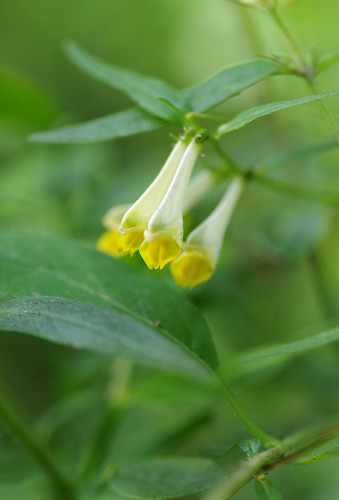
Common Cow-wheat (Melampyrum pratense)
Sherry has photographed this species several times before. Until now the colours always appeared much too bright and washed-out. Cow-wheat is found in many woodland sites on the moor and thrives in the shade.

Birch Polypore (Piptoporus betulinus)
This fungi is also known as Razor-strop. In olden times, before Edison lighted the world, barbers would apparently sharpen their razors on it.
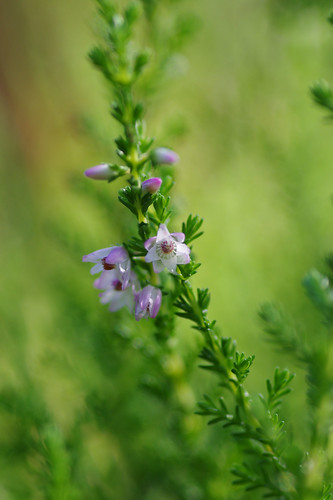
Ling flower
I was really impressed by this ling flower. There is so much heather around the moor that I have never taken the trouble before to look inside the flowers.
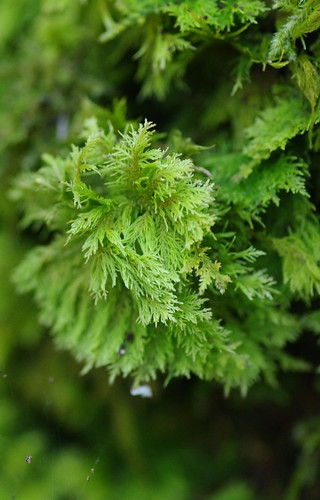
A feathery moss
Again I struggled with mosses and came off worse. But it has been well rendered and composed, as if through a silky gauze. There must have been a spider's web close to the tree.
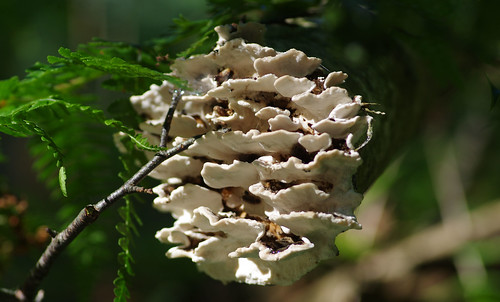
Jelly Rot Fungus (Phlebia tremellosa)
Many species of fungi damage the tree they grow on and can, in extreme cases, eventually kill the tree. Some, like this Jelly Rot, are capable of continually growing afterwards. I wonder if the process is merely random? Could fungi be able to detect the best or weakest trees? Somehow a tentative balance is likely struck which will ensure the survival of both with the help of the watchful eyes of a ranger.

Oak Curtain Crust (Hymenochaete rubiginosa)
This species is a lot darker than it appears in the guides. The description does state, however that it grows darker with age. Sherry took a number of shots, experimenting with different patterns and this was my favourite.
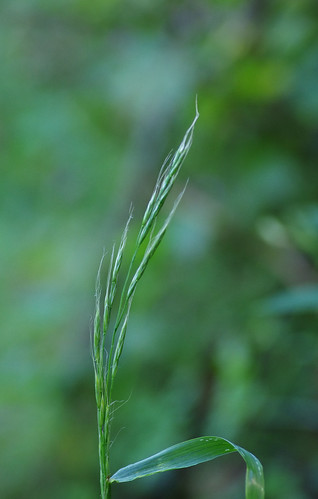
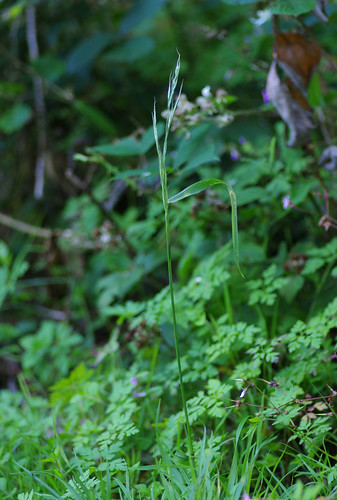
Wood False-brome (Brachypodium sylvaticum)
Here is another grass I have positively identified and added to our expanding species database.
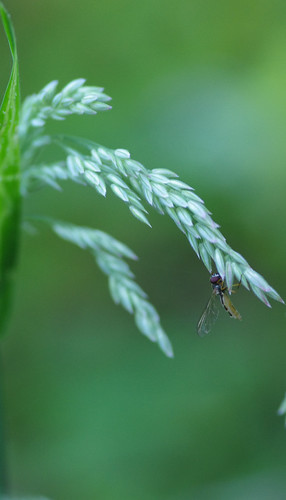
Fly on Yorkshire Fog (Holcus lanatus)
And here is our old friend Yorshire Fog again - thriving in a different habitat, in the cool green light of shade at the edge of the main path.
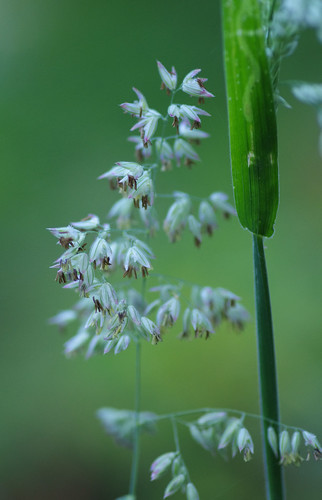
And a close-up of the specimen next to it
Finally, this shot showcases the emerging seeds.
WALK NOTES
There are a couple of trails to follow at Yarner Wood. If you are feeling more courageous you might like to combine an exploration of the wood with a foray onto the moor outside the reserve. In this case you will need OS Map OL28 DARTMOOR (North Sheet).
The small car park at Yarner Wood can be found at 782/788. There are information boards detailing recent sightings, bird hides by the pond and up the hill, a hut with more boards outlining Yarner's history as a reserve and a disused mine. The latter was the inspiration for Eden Philpotts' novel, first published in 1912, The Forest on the Hill.
Walking to the southern boundary of Yarner you will also join a section of the Templer Way, and the disused tramway. You can still see the remnants of the tracks in places. In its heyday, thousands of tonnes of granite were transported from the quarry near Haytor, down to the canal near Stover, to be taken on barges to Teignmouth and transported elsewhere.
There is much to see and do in Yarner Wood. Allow a few hours to pick up the feel of the place. At any time of year the woods can be a magical, mysterious, and admittedly sometimes a faintly sinister place to be. You will likely come away as I did, with more questions than answers, an altered sense of perspective, and most of all, an ardent wish to return.

Comments
Add a Comment